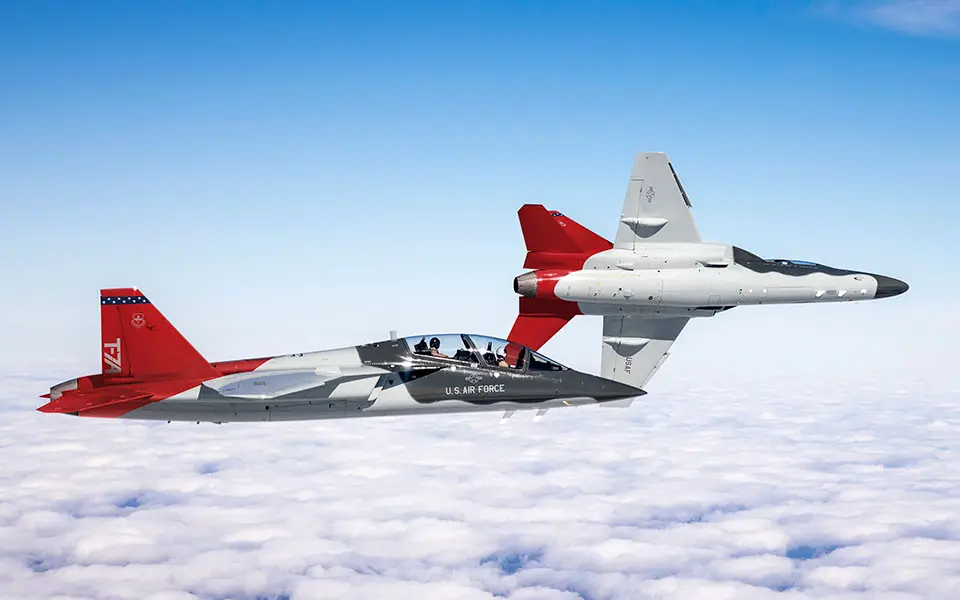Since the Air Force announced its intent to replace the T-38C Talon with the T-7A Red Hawk, various aspects of the successor have been studied to prepare the trainer jet for its imminent deployment. The examination of a critical component of the T-7A is underway at the Holloman High Speed Test Track at Holloman Air Force Base, New Mexico.
In January 2021, testing to qualify the T-7A ejection system began at the HHSTT. This ongoing testing is expected to continue through the beginning of 2022. The HHSTT, a rocket sled track that can test models of varying sizes up to full-scale at speeds of up to Mach 8, is operated by the 846th Test Squadron, part of the 704th Test Group at Holloman AFB. The test group is a unit of Arnold Engineering Development Complex, headquartered at Arnold Air Force Base, Tennessee. The 846th TS uses the HHSTT to provide customers with test data that includes lethality effects, impact survivability, separation dynamics and guidance system performance.
The 846th TS has utilized both the largest-class and smallest-class manikins in order to test the ejection system for the extremes of the body dimension envelope that the T-7A airframe is designed to meet. These manikins are fully-instrumented with a bevy of sensor variations and are outfitted in full aircrew flight equipment dress, which includes a flight suit, helmet and boots. Various safety modes of the T-7A ejection seat have been and continue to be tested at the HHSTT. These tests are designed to replicate all various profiles of the aircraft’s flight, such as stationary, slow-speed flight and high-speed flight. The T-7A System Program Office in the Air Force Life Cycle Management Center, which has overseen the procurement and qualification testing requirements and will oversee all acquisition acceptance testing of the new airframe, requested the ejection system testing at HHSTT. A holistic aircraft flight qualification testing regime is being completed elsewhere.

According to Capt. Landon Walrod, 846th TS project manager, “A fully-representative forebody sled was created for these ejection system tests. Test setup is quite extensive due to all the different buildup activities that have to take place. Massive amounts of collaboration and setup are also done for the photo optics collection for each test, capturing high-framerate, high-definition footage, from many different angles in order to document system performance, conduct injury analysis of the test manikins and ensure that all systems are functioning as desired before proceeding further into testing. The failure of the canopy fracturing system would result in an emergency mode backup ejection in which the canopy breakers on the seat and the catapult still have sufficient force to get the pilot and seat safely out of the cockpit. Other static tests are done to ensure that the entire operating envelope and ejection seat modes of the aircraft are tested” Walrod said.
In September 2018, the Air Force selected the Boeing T-X to replace the nearly-60-year-old T-38C Talon. The following year, it was announced that T-X had officially been named the T-7A Red Hawk. The Boeing-Saab T-7 Red Hawk, originally known as the Boeing T-X, is an American/Swedish advanced jet trainer produced by Boeing in partnership with Saab. In September 2020, it was announced that due to the digital engineering used to develop the aircraft, it would be designated as the first “eSeries” aircraft and would also be referred to as the eT-7A. The design officially entered series production in February 2021. In April 2021, Saab Group delivered one aft section of T-7A aircraft to the Boeing St. Louis plant. On 24 July 2021, Saab had delivered the second aft section to the Boeing St. Louis plant. Boeing will splice Saab’s aft section with the front section, fins, wings and tail assembly to become a complete test aircraft for use in the EMD’s flight test program.












